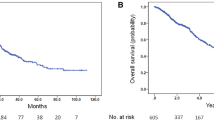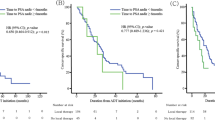Abstract
Purpose
We determine whether the nadir prostate-specific antigen level (PSA nadir) and time to nadir (TTN) during initial androgen deprivation therapy (ADT) are prognostic factors in metastatic castration-resistant prostate cancer (mCRPC) patients.
Methods
We reviewed the Michinoku Japan Urological Cancer Study Group database, including 321 mCRPC patients. Optimal cutoff values for PSA nadir and TTN on survival were calculated with the receiver operating characteristic (ROC) curve. Patients were stratified into unfavorable (higher PSA nadir and/or shorter TTN) and favorable (lower PSA nadir and longer TTN) groups. The inversed probability of treatment weighing (IPTW)-adjusted Cox proportional hazard model was performed to evaluate the impact of the unfavorable group on overall survival (OS) after CRPC diagnosis.
Results
Median age and follow-up period were 71 years and 35 months, respectively. ROC curve analysis demonstrated cutoffs of PSA nadir > 0.64 ng/mL and TTN < 7 months. The unfavorable group included 248 patients who had significantly shorter OS after mCRPC. The IPTW-adjusted multivariate model revealed that the unfavorable group had a negative impact on OS in mCRPC patients [hazards ratio (HR) 2.98, P < 0.001].
Conclusions
Higher PSA nadir and shorter TTN during the initial ADT are poor prognostic factors in patients with mCRPC.





Similar content being viewed by others
References
Siegel RL, Miller KD, Jemal A (2015) Cancer statistics, 2015. CA Cancer J Clin 65:5
Kakehi Y, Sugimoto M, Taoka R (2017) Evidenced-based clinical practice guideline for prostate cancer. Int J Urol 24:648
Kimura T, Egawa S (2018) Epidemiology of prostate cancer in Asian countries. Int J Urol 25:524
Komura K, Sweeney CJ, Inamoto T et al (2018) Current treatment strategies for advanced prostate cancer. Int J Urol 25:220
Mitsuzuka K, Arai Y (2018) Metabolic changes in patients with prostate cancer during androgen deprivation therapy. Int J Urol 25:45
Nakajima K, Kaneko G, Takahashi S et al (2018) Role of bone scan index in the prognosis and effects of therapy on prostate cancer with bone metastasis: study design and rationale for the multicenter Prostatic Cancer Registry of Standard Hormonal and Chemotherapy Using Bone Scan Index (PROSTAT-BSI) study. Int J Urol 25:492
Akamatsu S, Inoue T, Ogawa O et al (2018) Clinical and molecular features of treatment-related neuroendocrine prostate cancer. Int J Urol 25:345
Mizokami A, Kadono Y, Kitagawa Y et al (2017) Therapies for castration-resistant prostate cancer in a new era: the indication of vintage hormonal therapy, chemotherapy and the new medicines. Int J Urol 24:566
Parimi S, Chi KN (2016) Chemotherapy for metastatic castration-sensitive prostate cancer. Int J Urol 23:726
Shiota M, Namitome R, Kobayashi T et al (2018) Prognostic significance of risk stratification in CHAARTED and LATITUDE studies among Japanese men with de novo metastatic prostate cancer. Int J Urol. https://doi.org/10.1111/iju.13870
Tilki D, Pompe RS, Bandini M et al (2018) Local treatment for metastatic prostate cancer: a systematic review. Int J Urol 25:390
Okamoto T, Hatakeyama S, Narita S et al (2018) Impact of nutritional status on the prognosis of patients with metastatic hormone-naïve prostate cancer: a multicenter retrospective cohort study in Japan. World J Urol. https://doi.org/10.1007/s00345-018-2590-2
Teoh JY, Tsu JH, Yuen SK et al (2015) Prognostic significance of time to prostate-specific antigen (PSA) nadir and its relationship to survival beyond time to PSA nadir for prostate cancer patients with bone metastases after primary androgen deprivation therapy. Ann Surg Oncol 22:1385
Tomioka A, Tanaka N, Yoshikawa M et al (2014) Nadir PSA level and time to nadir PSA are prognostic factors in patients with metastatic prostate cancer. BMC Urol 14:33
Choueiri TK, Xie W, D’Amico AV et al (2009) Time to prostate-specific antigen nadir independently predicts overall survival in patients who have metastatic hormone-sensitive prostate cancer treated with androgen-deprivation therapy. Cancer 115:981
Huang SP, Bao BY, Wu MT et al (2011) Impact of prostate-specific antigen (PSA) nadir and time to PSA nadir on disease progression in prostate cancer treated with androgen-deprivation therapy. Prostate 71:1189
Sasaki T, Onishi T, Hoshina A (2011) Nadir PSA level and time to PSA nadir following primary androgen deprivation therapy are the early survival predictors for prostate cancer patients with bone metastasis. Prostate Cancer Prostat Dis 14:248
Kim M, Lee J, Jeong CW et al (2015) Prostate-specific antigen kinetic profiles during androgen deprivation therapy as prognostic factors in castration-resistant prostate cancer. Urol Oncol 33:203 e1
Okubo T, Mitsuzuka K, Koie T et al (2018) Two years of bicalutamide monotherapy in patients with biochemical relapse after radical prostatectomy. Jpn J Clin Oncol 48:570
Matsumoto T, Hatakeyama S, Ookubo T et al (2017) Cost-effectiveness comparison between neoadjuvant chemohormonal therapy and extended pelvic lymph node dissection in high-risk prostate cancer patients treated with radical prostatectomy: a multi-institutional analysis. Med Oncol 34:190
Scher HI, Halabi S, Tannock I et al (2008) Design and end points of clinical trials for patients with progressive prostate cancer and castrate levels of testosterone: recommendations of the Prostate Cancer Clinical Trials Working Group. J Clin Oncol 26:1148
Sweeney CJ, Chen YH, Carducci M et al (2015) Chemohormonal therapy in metastatic hormone-sensitive prostate cancer. N Engl J Med 373:737
Fizazi K, Tran N, Fein L et al (2017) Abiraterone plus prednisone in metastatic, castration-sensitive prostate cancer. N Engl J Med 377:352
Austin PC, Stuart EA (2015) Moving towards best practice when using inverse probability of treatment weighting (IPTW) using the propensity score to estimate causal treatment effects in observational studies. Stat Med 34:3661
Chung CS, Chen MH, Cullen J et al (2008) Time to prostate-specific antigen nadir after androgen suppression therapy for postoperative or postradiation PSA failure and risk of prostate cancer-specific mortality. Urology 71:136
Harshman LC, Chen YH, Liu G et al (2018) Seven-month prostate-specific antigen is prognostic in metastatic hormone-sensitive prostate cancer treated with androgen deprivation with or without docetaxel. J Clin Oncol 36:376
Hussain M, Tangen CM, Higano C et al (2006) Absolute prostate-specific antigen value after androgen deprivation is a strong independent predictor of survival in new metastatic prostate cancer: data from Southwest Oncology Group Trial 9346 (INT-0162). J Clin Oncol 24:3984
Kitagawa Y, Ueno S, Izumi K et al (2014) Nadir prostate-specific antigen (PSA) level and time to PSA nadir following primary androgen deprivation therapy as independent prognostic factors in a Japanese large-scale prospective cohort study (J-CaP). J Cancer Res Clin Oncol 140:673
Yamada Y, Sakamoto S, Amiya Y et al (2018) Treatment strategy for metastatic prostate cancer with extremely high PSA level: reconsidering the value of vintage therapy. Asian J Androl 20:432
Mahal BA, Yang DD, Wang NQ et al (2018) Clinical and genomic characterization of low–prostate-specific antigen, high-grade prostate cancer. Eur Urol 74:146
Acknowledgments
We would like to thank Teppei Okamoto, Takuma Narita, Naoki Fujita, Hiromichi Iwamura, Yuki Fujita, Yukie Nishizawa, and the entire staff of the Department of Urology in Hirosaki University for their invaluable help with the data collection. The authors would also like to thank Enago (www.enago.jp) for the English language review.
Funding
This work was supported by a Grant-in-Aid for Scientific Research (Grant Nos. 15H02563, 15K15579, 17K11118, 17K11119, 17K16768, 17K16770, 17K16771, 18K16681, 18K16682, 18K16717, 18K16718, 18K16719, and 18K09157) from the Japan Society for the Promotion of Science.
Author information
Authors and Affiliations
Contributions
IH: manuscript writing, data analysis. SH: manuscript editing, data analysis. SN, MT, TS, SK, SH, MI, TK, SI, JS, HS, KM, and TT: project development, data collection. NT, YA, TH, and CO: project development, critical review and supervision
Corresponding author
Additional information
Publisher's Note
Springer Nature remains neutral with regard to jurisdictional claims in published maps and institutional affiliations.
Rights and permissions
About this article
Cite this article
Hamano, I., Hatakeyama, S., Narita, S. et al. Impact of nadir PSA level and time to nadir during initial androgen deprivation therapy on prognosis in patients with metastatic castration-resistant prostate cancer. World J Urol 37, 2365–2373 (2019). https://doi.org/10.1007/s00345-019-02664-3
Received:
Accepted:
Published:
Issue Date:
DOI: https://doi.org/10.1007/s00345-019-02664-3




